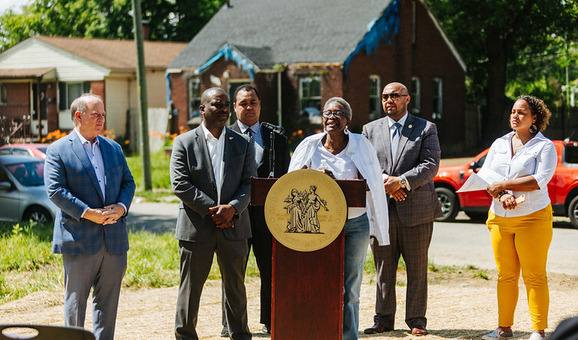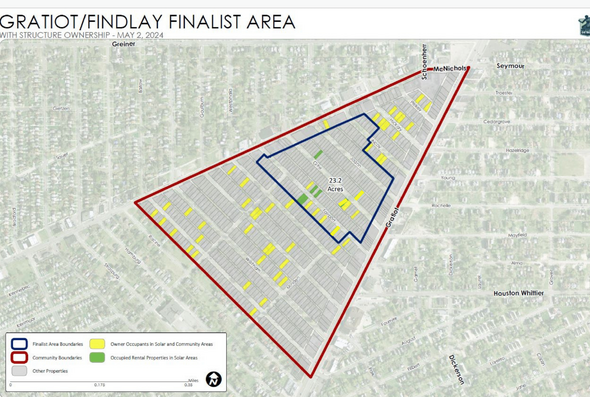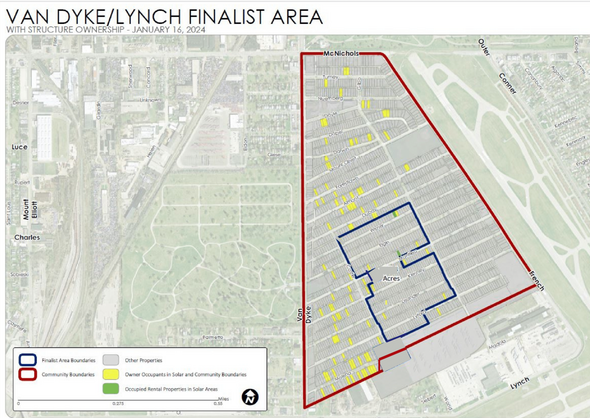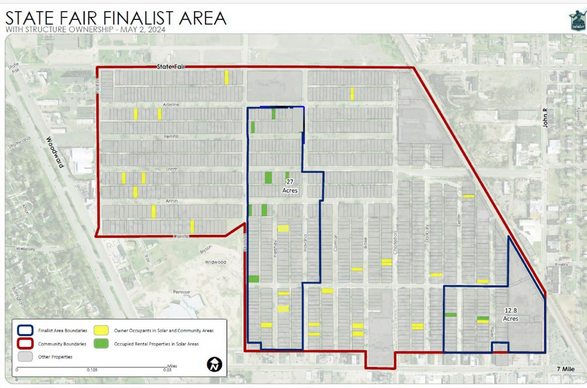Mayor Announces First 3 Solar Neighborhoods; tells residents, “you have not been forgotten"
- Gratiot/Findlay, Van Dyke/Lynch, and State Fair neighborhoods selected to host first three solar arrays, following extensive seven months of community engagement
- The Solar Neighborhood Project aims to repurpose blighted vacant land for solar energy, make Detroit a national leader in fighting climate change
- Leading national solar developers Lightstar Renewables and DTE Electric Company to share development equally
- Five other neighborhoods remain finalists for expected 2nd phase of program
Residents in three Detroit neighborhoods who have lived for decades adjacent to some of Detroit’s worst blight got a clear message today from Mayor Mike Duggan: You have not been forgotten.
Today, the Mayor joined with residents of the Gratiot/Findlay, Van Dyke/Lynch and State Fair communities to announce that they are the phase 1 selections to become Detroit’s “solar neighborhoods.” Combined, the three areas would create a total of 103.9 acres of solar arrays and bring the city halfway to its goal of creating approximately 200 acres of solar arrays to generate enough clean energy to offset the electricity used by all 127 city municipal buildings.
“Detroit can take real action to fight climate change and address some of the worst blight in the City,” Mayor Duggan said. “Detroit is now becoming the center of Michigan’s fight to address climate change.”

Detroit’s Twin Goals of Reducing Neighborhood Blight and Fighting Climate Change
Detroit’s 127 municipal buildings consume 33 megawatts of electricity from traditional sources. Detroit would need to build 200 acres of solar arrays to generate 33 megawatts of renewable energy to offset the power demands of city buildings.
Phase-in of the construction of the 6 solar neighborhoods
In June 2023, Mayor Duggan announced the city was seeking neighborhood groups who wanted to address blight in their communities by constructing solar fields in the most blighted areas and providing community benefits in the form of home improvements to the adjoining neighborhood. After 1 year, the process has narrowed to 8 finalists with overwhelming community support.
Phase 1: The Mayor Friday submitted to City Council the proposals to proceed to build the solar fields in the first 3 neighborhoods, totaling 104 acres. This will start the process of land acquisition, neighborhood community benefits, and solar field installation.
Phase 2: By early 2025, the administration will recommend to City Council 3 more neighborhoods from the 8 finalists, allowing the City to build out the entire 200 acres powering 33 megawatts of renewable energy.
The Land acquisition process
All Phase 1 owners of owner-occupied homes have already entered into written agreements for voluntary buy-outs by the City. In the 104 acres in Phase 1, the extensive neighborhood and legal outreach have identified only 21 owner-occupied homes. All 21 homeowners have indicated their desire to move from the neighborhood and all have signed option contracts for an agreed-upon price.
Renters in the Phase 1 area will receive the cost of relocating and 18 months free rent in their new home, pursuant to Michigan condemnation law.
Condemnation will be used to acquire the property of landlords and vacant landowners, who will be paid fair market value for their property pursuant to Michigan condemnation law.
“I am excited about the solar idea,” said State Fair resident and homeowner Gloria McHenry. “I like that we are trying to get Detroit clean. For so many years it has been a dumping ground in this area and an area that everyone had forgotten about. I thought it would never happen, but I really like the idea of the solar to come to the state fair with that investment it will bring our beautiful City of Detroit back it's been too long.”
Home improvement community benefits for 159 adjoining homeowners
There are 159 documented owner-occupied homes in the areas adjoining the new solar fields. The homeowners selected the boundaries of the adjoining community benefits zones. Those 159 homeowners will receive home improvements ranging from $15,000 to $25,000 (depending on the number of solar acres). The eligible home improvements are energy efficiency upgrades to the homes, options such as:
- Windows
- Repairing roofs
- Residential solar panels
- Energy-efficient appliances
- Home insulation and air sealing
- Energy-efficient furnaces and hot water heaters
- Installing smart thermostats
- Energy-efficient lighting
- Battery backup
These homeowners who stayed will get the double benefit of having the most blighted areas replaced by solar fields and will have their neighborhood homes upgraded with new investment.
“The solar project is a great opportunity for the revitalization and stabilization of Penrose, combining the community benefit investment into homes along with the establishment of home values while occupying desolate areas that attract dumping and other activities,” said resident John Mcannich.

Two solar field developers selected – each will build 3 solar fields with approximately 100 acres
Following an extensive bid process, the City identified two highly qualified developers to build Detroit’s solar field. Rather than award all 6 solar fields to one company, the city decided Detroit would be better served by having 2 companies, each with responsibility for half the project.
Lightstar Renewables, one of the nation’s leading solar developers, has been selected to build 63 acres of solar fields in the Gratiot/Findlay and State Fair neighborhoods in Phase 1. Lightstar Renewables is headquartered in Boston and is generating more than 100 Megawatts of energy across 20 solar developments in the US. DTE Electric Company, which is operating more than 30 solar fields across Michigan – the largest being 250 acres in Lapeer – has been selected to build the 40-acre solar field in the Van Dyke/Lynch neighborhood. In Phase 2, we expect DTE Electric Company to be awarded 2 additional neighborhoods and Lightstar Renewables to be awarded 1, with the goal of having the solar projects divided as evenly as possible between the two companies.
Several non-profits have worked as advocates with the neighborhood groups throughout this process and will continue to work for those neighborhood groups through the entirety of the process.
The City of Detroit will maintain ownership of all of the land and will lease it to the developers.
“It is exciting to see these solar neighborhoods take another step closer to the promise of producing clean energy in Detroit,” said City Councilmember Scott Benson. “I want to thank everyone who participated in the community engagement process and developed the community benefits. We are thrilled to get this project moving forward so we can meet our goal of 100 percent offset of municipal energy usage with renewable sources.”
Funding for the Project – Made Possible by Tax Credits from the Inflation Reduction Act
Mayor Duggan explained the reason city is undertaking the solar power project now is that it only became financially viable because of the Inflation Reduction Act of 2022. “President Biden reduced the costs of large-scale solar projects like Detroit’s by 30% through the automatic tax credits in the Inflation Reduction Act,” the Mayor said. “Communities across America need to stop talking about fighting climate change and start to act. Under the new law, large-scale solar projects make good financial sense.”
Capital Costs will be paid by the City of Detroit’s Utility Conversion Fund. This is a long-standing fund dating back to the days when the city operated its own power system. That fund is legally required to be used for energy conversion. $14 million for the upfront costs of acquiring and clearing the land will be paid from the existing fund. No new appropriation will be needed.
Net operating costs are projected to increase $1.1 million per year. The City of Detroit currently spends nearly $2.4 million per year within the boundaries of the three blighted solar field zones across several departments:
- Constant illegal dumping and trash pickup
- Mowing and maintenance of overgrown lots and abandoned houses
- Police and fire runs
- Street maintenance, building inspections and enforcement, storm water backups and repairs
On an annual basis, the City projects the costs of the Phase 1 solar fields as follow:
Annual operating cost $5.5 million
Renewable energy savings offset ($2 million)
City department cost reductions ($2.4 million)
Savings from solar fields $4.4 million
Total Net Costs $1.1 million
“We have seen property values and income tax revenues grow dramatically in other neighborhoods where the city has made investments,” Mayor Duggan said. “I’m confident our $1.1 million a year investment in these long-forgotten neighborhoods will produce a real recovery in these communities.”
Council member at large Coleman Young, II expressed his sense of urgency to act.
“We need this program for clean energy, better environment and lower taxes. If this doesn’t pass it’s less money for police, fire, emergency services and housing and more money out of your pocket for energy costs. The citizens of Detroit are already overburdened with energy cost. This is a cost savings for the Detroit Community.”
Equity fund for homeowners caught in limbo waiting for Phase 2
The 5 remaining neighborhoods competing for Phase 2 selection will not know their future until 2025. There are 31 owner-occupied homes in those 5 neighborhoods, 28 have already signed letters of intent to sell their homes, if selected, but they are now placed in a limbo period in which it will be impossible to do anything with their homes. The City is proposing a $4.4 million equity fund, paid from reserves in the Utility Conversion Fund, so that any of those 31 homeowners can exercise their option to sell their homes and move out of the neighborhood.
“These are all individuals who have expressed support for the purchase of their home for a solar array but have been in limbo because they don’t know if or when a solar array may come,” said Group Executive for Neighborhoods, Ray Solomon. “We felt it was the right thing to do from a moral standpoint to take away the uncertainty and allow them to accept the purchase of their home, if that is their wish.”
Solar Fields required to be returned to the City as greenfield sites when no longer generating power
Under the agreements, the Solar Fields will operate for 35 years generating solar power. Whenever their useful life as solar fields comes to an end, the contracts require the developers to remove all of the solar equipment and return the property to the city as a green field.
“We have the best of all worlds with this agreement,” said Director of Sustainability Tepfirah Rushdan. “These 200 acres will be used to produce renewable energy to fight climate change for decades into the future. When they are done with that purpose, the city has cleared, greenfield land to plan the next purpose. This is what sound stewardship of land should look like.”
No zoning changes required for a city public project
Under Michigan law, residential use zoning restrictions do not apply to city decisions to site city projects like police stations, fire stations, parks, recreation centers, and utilities. The city is creating city-owned solar fields to generate renewable energy to offset the electricity demands of city buildings. No zoning changes are required.
Next Steps
To begin the next step of the process, the Mayor’s office has transmitted several documents to City Council for approval. Those include:
- Resolution for the acquisition of private property in each of the three neighborhoods to assemble the land needed for the proposed solar arrays
- Contracts with two developers selected following a procurement process
- Resolution to create an equity fund for voluntary purchases of owner-occupied homes in the five remaining solar neighborhood finalist areas.
Details of the community benefits in each neighborhood:
Gratiot/Findlay:
- 23.2 acres of solar
- 9 relocation homeowners within the Solar Array
- 36 Community Benefit homeowners who will receive $17,000 each in energy efficiency upgrades

Van Dyke/Lynch:
- 40.9 acres of solar
- 7 relocation homeowners within the Solar Array
- 85 Community Benefit homeowners who will receive $15,000 each in energy efficiency upgrades

State Fair:
- 39.8 acres of solar
- 5 relocation homeowners within the Solar Array
- 38 Community Benefit homeowners who will receive $25,000 each in energy efficiency upgrade

Neighborhood Solar Partners (NSPs)
A group of community-based neighborhood solar partners has been assisting residents through this process, including:
- Green Door Initiative
- EcoWorks
- D2 Solar
- MI Interfaith Power and Light
- Peace Tree
- Sustainable Community Farms
- Walker-Miller Energy
- Rescue MI Nature
- Worldwide Management Services Corporation/Communities Power
- Ryter Cooperatives
- First Family Solar
- Anti-Gravity, LLC
- SDEV
- Energy Alliance